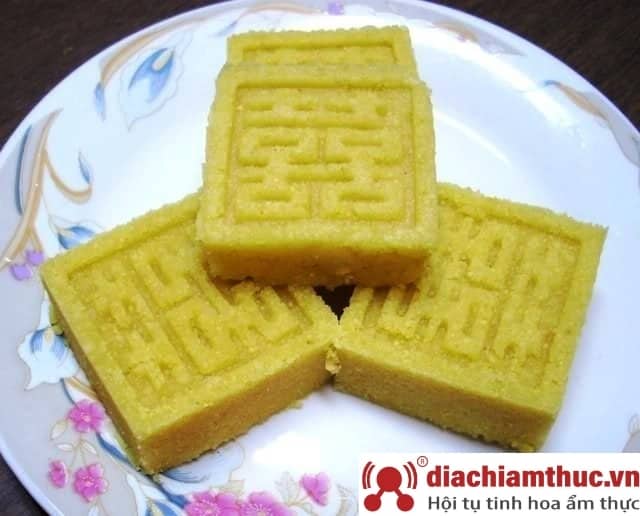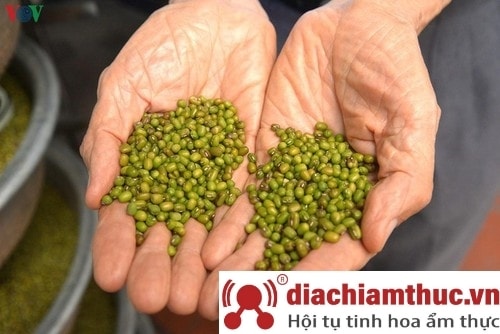Hanh Tu green bean cake comes from the family of Mrs. Le Thi Phuc at 249, Le Hong Phong, Nam Dinh city. The reason why many people love and become a specialty of Nam Dinh is because the cake is very unique. The cake here is made from green beans, pomelo oil, lard and white granulated sugar. And under the skillful hands of the person who made the cake, it has created a unique and unmistakable delicious taste. Hanh Tu green bean cake is delicious because the maker is always careful during the selection of ingredients. Do not add extra ingredients, to create the natural flavor of the cake.

Hanh Tu green bean cake
INGREDIENTS FOR Mung Bean Cake
On the other hand, it depends on the long-term experience of the baker to get Hanh Tu green bean cake. True to the quality of the heirloom, the taste makes many people miss it. Ingredients for making mung bean cake include: green beans, white granulated sugar, lard and fragrant pomelo oil. The selected green beans must be the type of beans grown in Y Yen, Vu Ban districts, are the first beans of the season, the seeds are large, etc. The cake sugar must also be the type of sugar, alum sugar brought out from the central provinces. mainly from provinces such as Quang Nam, Quang Ngai, etc.

Ingredients for making green bean cake
Lard must choose the right type of lard to make the cake taste good. Processors will fry lard to get clear water. Condensed sugar is mixed with bean paste, adding a little fragrant grapefruit oil to give the cake a characteristic light aroma. Use the rolling ball to knead well, puree, cool, then add the lard to practice. Just practice until it is flexible and can be closed into the mold. The stitching of the cake into the mold must be gentle and careful, the new cake will be square and beautiful. When finished processing, the cake will have a characteristic dark yellow color of the cake. There is a sweet aroma of green beans, grapefruit flowers and clearly two words Hanh Tu.
Source: Collected internet.
Eight UNESCO world heritage sites stretch across Vietnam. Each place offers interesting perspectives on local life and majestic natural beauty. The Imperial Citadel and Hue mausoleums take you back to the Nguyen Dynasty full of ups and downs. Hoi An ancient town was once a bustling meeting point for ships and traders around the world. Throughout other provinces and cities, you will encounter ancient relics, poetic scenes, and vivid pieces that create the picture of Vietnamese heritage.
Vietnam has an area of 331,690 km², located in the east of the Indochina peninsula, in Southeast Asia. Sharing a border with three countries, Vietnam borders China to the north, Laos and Cambodia to the west, and the East Sea to the east. In 2019, Vietnam's population was more than 96 million people, ranking 13th in the world. Hanoi, the capital of Vietnam, is the second largest city with 6.2 million people, after Ho Chi Minh City, 8.8 million people.
Vietnam's history began from 1 to 2 thousand years BC. Over many centuries with the Ly, Tran, Le, and Nguyen dynasties, from the mid-19th century, Vietnam became a French colony. After the August Revolution, the Democratic Republic of Vietnam was born. The Battle of Dien Bien Phu in 1954 marked the end of the French in the territory, but Vietnam was divided into two countries: the Democratic Republic of Vietnam in the North and the Republic of Vietnam in the South. After the events of April 30, 1975, Vietnam was unified and from July 2, 1976, officially named the Socialist Republic of Vietnam.
Hang Market (Hai Phong) was formerly the market of an ancient village called Du Hang (17th-18th centuries). The Du Hang village area was formerly agricultural land and a traffic hub, so Hang market became a place to meet, exchange, and buy and sell plants, animals, and farming utensils. The urbanization process spread to the suburbs, so today Hang Market is located entirely in the inner city, in Du Hang Kenh ward, Le Chan district, Hai Phong city. Even though many years have passed, the customs of exchanging agricultural goods of c